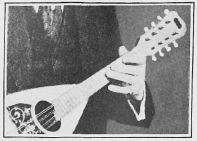Mandolin Self Instructor, online tutorial - Page 12
A simplified self learning system for the Mandolin with tuning instruction, song folio, chord diagrams, sheet music and PDF for printing. By ZARH MYRON BICKFORD
| Share page | Visit Us On FB |
|
THE FINGERS OF THE LEFT HAND |
||
|
The action of the fingers must be entirely from the third joints, the first twT
joints being kept in a curved and stationary position. The tips of the fingers are used to press the strings, the nails being kept
somewhat short so as not to interfere with the action of the fingers. The accompanying cut shows the manner of placing the fingers on the
strings, as well as the position of the thumb. In the cut, the first, second and third fingers are placed at the second, fourth, and fifth frets, respectively, of the third string, with the fourth finger held in proper position, either to drop to the sixth or seventh fret, or not, as the case may be, since this finger must always be kept in a line with the fingers being used, instead of being curled back in the hand or dropped below the fingerboard. This position of the fingers and particularly the fourth finger, is most essential and cannot be too strongly impressed on the mind. Particular attention should be paid to the position of the thumb, as shown in the cut, noting that the tip is below the top of the fingerboard and that the joint is straight. Careful attention to these seemingly small matters will have a very direct bearing on all future progress. In order to develop a decisive action of the fingers they must not merely be laid on the strings, but must be dropped
with a quick and forceful little blow, like the action of a little hammer. The finger tips must always be dropped close to the frets at which notes are to be made, touching the fret, instead of merely placed between *he required fret and that preceding. This is essential to a good tone, although the mistake must not be made of placing the finger on top of the fret, since this would be as bad as to have it too far away. It is also essential that fingers be left in place on the strings as long as possible, as in the case of ascending passages
(playing toward the bridge), when the first, second and third fingers remain firmly in place so long as the playing is con- fined to that particular string. When the playing is transferred to another string, the fingers are all removed at the same instant. This is a most important rule and will be referred to very frequently throughout the work.  |
||
|
THE RIGHT ARM AND HAND |
||
|
Unlike that of the violinist, the mandolinist's right arm must perform two functions—holding the instrument in
position and manipulating the pick. This double duty requires a more fixed and rigid position than when the arm merely draws a bow across the strings.
The first consideration, then, is to hold the instrument firmly in place and this is done by bringing the forearm easily around the upper edge of the instrument, resting it just above and preferably against the tailpiece, at a point about mid- way between the elbow and wrist joints. It will be found that this position, aside from its being a perfectly normal and natural position for the arm to take, allows the hand to exactly balance the elbow and the rest of the arm. This balancing is very important, since it relieves all strain and tension in the muscles of the arm and wrist and allows
a freedom which can be obtained in no other way. After the arm has been thus balanced, if the mandolin is held well to the right, as previously explained, the natural weight of the hand will bring it down to the strings so that the pick will strike at a point about half way between the bridge and the end of the fingerboard and usually near the back edge ot the soundhole. This is the normal position of the arm, wrist and hand, and must be strictly adhered to. With the mandolin and right arm both in the proper position, as explained and shown in the cuts, the question of keeping the wrist arched takes care of itself, since if it did not curve downward toward the strings, it would swing in mid-air. The secret of maintaining this easy, graceful and normal position is to allow the elbow to hang and balance easily,
rather close to the side, instead of raising it and holding it in a rigid position. The general position of the hand and arm is shown in the cuts on a previous page. |
||